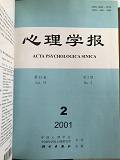|
|
A STUDY ON THE DEVELOPMENT CHARACTERISTICS OF ACHIEVEMENT MOTIVATION IN ADOLESCENTS
Wo Jianzhong Huang Huazhen Lin Chongde (Development Psychology Institute, Beijing Normal University, Beijing 100875)
2001, 33 (2):
160-169.
This research was designed to aim at exploring the development characteristics of hierarchical achievement motivations and the structure models using 4 measurements of academic achievement attribution, autonomic motivation, fancy self-efficacy and learning goals among 652 student subjects from two high schools, the results were as follows: 1 There was stable development of internal and controllable efforts and external uncontrollable task difficulties with the increase of school grades; students attribute their academic achievements to their abilities increase, but decreases at Grade 3, then it increases again at Grade 4,5 & 6; about luck-attribution, there are two highpoints at Grade 2 & 4, the rest goes according to the same direction; on the whole, at the time of high school, the student' s academic achievement attributions are in the following order: internal and controllable efforts, internal uncontrollable abilities, external uncontrollable task difficulties and luck. 2 Autonomic motivation factors keep stable basically in the development direction at the whole high school period; but there are different development levels at different dimensionalities, at the choice of task difficulties, the students in Grade 3 & 6 intend to choose easy tasks, and the rest for the opposite; about their ambitions, the level is unstable: in Grade 2 & 6 it is at the highest point, in Grade 3, near to the point and Grade 5, is at the lowest point; as to emotion, Grade 1, 3 & 6 are at the highest level, but Grade 2 & 5, at the lowest level; gender main domino effects are not salient at the 4 dimensionalities; The affected functions of grade and gender are only lying in emotion. 3 It is basically stable that the development of efficacy goes; but with the increase of school grades, it gradually decreases from Grade 1 to 4, and from Grade 4, it increases again; the level of creative efficacy in 6 years is not high, from the change of grade, it decreases from grade I to 3, but increases at Grade 4, it decreases again to Grade 6; the boys are superior to the girls at the sections of learning & creative efficacies. 4 Master goals keep stable basically in the development direction during the whole high school period; but there are different development levels at different dimensionalities: in intellectual view, the students of Grade 1, 4 & 6 are inclined to take intelligence for the development through practice, but the others think differently; in the valuation view, Grade 1 & 4, intend to admire learning efforts, but Grade 2, enjoy their abilities; on success, Grade 4 is preponderated over others; on defeat, Grade 2 & 5, more take it for denying ability and effort; performance goals change with grade, the valuation view increases from Grade 1 & 2, but decreases from Grade 2 to 4, again going upward from Grade 4 to 6; success view is high at Grade 3; gender effect is not salient.
Related Articles |
Metrics
|




